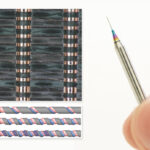ASIA ELECTRONICS INDUSTRYYOUR WINDOW TO SMART MANUFACTURING
Ultrapure Water Analyzers Support Recovery in Plants
Semiconductor manufacturing sites use large amount of ultrapure water to clean wafers and to wash away or dilute chemical. Some of the water are recovered and reused. In this process, measurements are carried out to determine whether Total Organic Carbon (TOC), which is the amount of carbon in organic matter in water, is below a certain level. The results are then used as criteria for reuse.
TOC-780 Automatic Analyzer
TOC-780, an automatic analyzer offered by Toray Engineering D Solutions Co., Ltd. (TDS), measures the absolute TOC value of ultrapure water. In the analyzer, inorganic carbon is removed using a scrubber. After this process, organic carbon is oxidized and converted to carbon dioxide using a reactor to apply ultraviolet (UV). Then, the concentration of the gas is measured using an infrared analyzer.

Achieving Zero Value
At a semiconductor plant, it is impossible to completely avoid the risk of water being contaminated with a tiny amount of organic matter, even if it is ultrapure water with very few impurities. Even a test reagent used to remove inorganic carbon beforehand contains a little amount of organic matter. Therefore, when controlling the quality of recovered water, it is important to consider contamination with organic matter to determine an appropriate “zero value” by calculation.
TOC-780 oxidizes the sample by UV irradiation. Meanwhile, TOC-200 heats the sample water in its high-temperature combustion furnace. It converts organic components in the sample to carbon dioxide (CO2) and calculates the TOC value from the amount of the CO2.
As organic components contained in ultrapure water are extremely minimal, they are sufficiently oxidized by UV. However, when water discharged from factory is treated, UV may result in a lack of oxidation, and combustion is more effective.
Low-Temperature Sealing
TOC-200 puts a 30-microliter portion (equivalent to a single drop of eyewash) of the sample water into the combustion furnace. Then, it measures CO2 in the vaporized sample. In this measurement, it ensures sealed complete combustion at a relatively low temperature.
When heating the sample water, it closes the furnace with the valve to create a “steaming” environment. Similar products increase the temperature to around 1000°C. However, this system can achieve complete combustion at a low temperature of 650°C, allowing reduction of power consumption.
In sealing, impurities such as fine particles are prevented from scattering and damaging the analyzer during combustion. This is another advantage of sealing, and the structure reduces the frequency of maintenance, according to the company.
It also has a unique mechanism to prevent filter clogging. Normal filters are in the form of mesh or sponge. However, TDS employed an automatic cleaning filter (ACF) that consists of several tens of stainless-steel disks stacked at intervals of approximately 140µm. The sample water passes across the rotating disk. In this way, suspended matter that could result in dirt or clogging is scraped off and discharged from a drain.
The TOC analyzers are used at Toray’s factories. During product launch, TDS can refer to feedbacks to make improvements, like increasing the diameter of drainage pipes to prevent clogging. TDS responds to users’ diverse needs by utilizing the knowledge of the Toray Group, which places great emphasis on maintainability.




